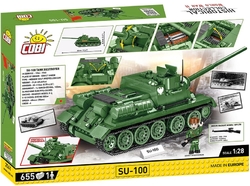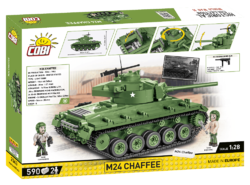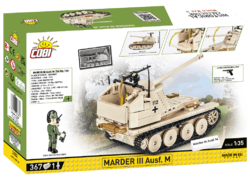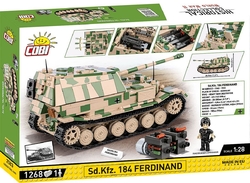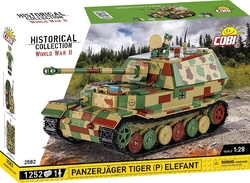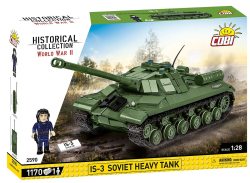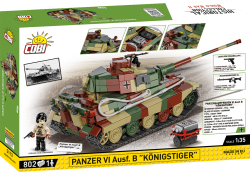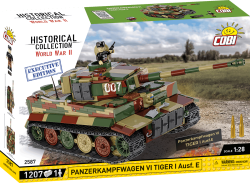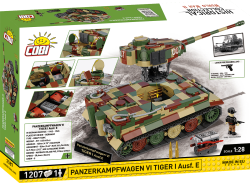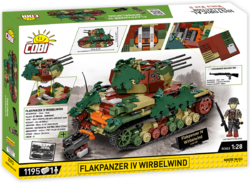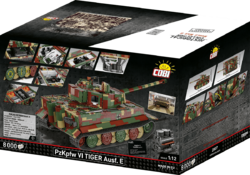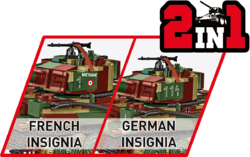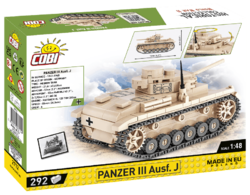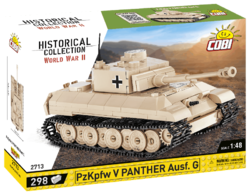Model kitl of the British tank MARK I in the Male version. The tank is produced in field camouflage with the designation C.19. This tank is kept on display at the Tank Museum in Bovington. The assembled model has rotating gun turrets with adjustable gun sights. The tank tracks are functional and the model can be easily driven on a non-slip surface. The package also includes a driver-mechanic figure and a cube with a description.
Show more
0 %
(0 Ranking)
1 012 Kč
pcs
Add to Cart
In stock - ready to ship (2 pcs)
| List Number: | COBI-2993 |
| EAN: | 5902251029937 |
| Warranty: | 24 months |
| Manufacturer: | COBI |
| Loyalty Points: | 7 |
| Price excluding VAT: | 836,40 Kč |
Description
Parametres
Files and Links
Discussion
Reviews

You know that:
- The tank was developed and manufactured by the British agricultural equipment company William Foster & Co. founded in 1846.
- At the beginning of their development, armoured armed vehicles were called Land ships, i.e. land ships, and from there, mainly for reasons of concealment from the enemy, soldiers and workers referred to them as tanks, i.e. water tanks.
- The Mark I was the first tank deployed in the Battle of the Somme on 15 September 1916 but it was not the first British-made tank. That primacy belongs to the 1915 experimental machine "Little Willie".
The tank was first shown to the Ordnance Commission in February 1916, then still officially known as 'His Majesty's Land Ship Centipede'. The machine made a strong impression on the officials. The first 27 units were ordered from the manufacturer. - The designers W. Foster and W. Tritton designed a tank with a low centre of gravity and a length suitable for crossing German trenches. Originally, the tank was to be driven by two people, but W. Foster disagreed with this concept and later proposed a single driver solution.
- The tank versions were divided into Male (male) armed with guns and Female (female) carrying only machine guns.
- The service of the tank crew was extremely demanding. 7-8 men had to fit into the small space. The noise, the cramped space, the vibrations, the fumes from the gunshots and the temperature of up to 50°C made the tank a hell of a machine. It often happened that the crew lost consciousness due to the environment inside the tank.
- Also unfortunate was the location of the fuel tank over the driver's head. You can probably imagine what happened after the tank hit.
- Despite all the disadvantages, the first deployment of tanks in combat was a great triumph. When 32 British tanks emerged from the fog on the morning of 15 September, panic reigned in the German trenches.
In all, 150 were produced in several modifications. - The Mark I tank, numbered C.19, is still preserved in the Bowington Tank Museum.
Technical parameters:
- dimensions: length 7.93 m, width 4.13 m, height 2.45 m
- weight 28 500 kg
- armour 16 mm front, 12 mm side, 12 mm rear, 6 mm top and bottom
- power plant Daimler-Knight petrol engine with 78 kW
- fuel tank capacity approx. 450 l
- number of gears 4 forward + 1 reverse
- maximum speed 6 km/h
- range 38 km
- main weapon 2x Hotchkiss cannon of 57 mm calibre (207 shots)
- secondary weapon 4x Hotchkiss MG machine gun 7,62 mm calibre
- crew 8
Albert Einstein about the Mark tank:
Tank Mark was a show of human spirit and inventiveness. It was an attempt to overcome the horrors of war through technology. Unfortunately, it was also just another war machine."
Assembly instructions
| Number of figurines | 1 pcs |
|---|---|
| Version (series) | 10/2023 |
| Scale | 1:35 |
| Dimensions after assembly | 28 x 13 x 9 cm |
| Box dimensions | 45 x 30,5 x 6 cm |
| Number of pieces | 878 pcs |
| Recommended age | 9+ |
| Package weight | 970 g |
| Collection | Great War |
| Contains luminous blocks | Ne |
| Material | Plastic |
| Compatible with other brand of kits | Yes |
Discussion is empty.
There is no review for product yet
Other categories
Related Items
Last viewed products
You might be interested










































